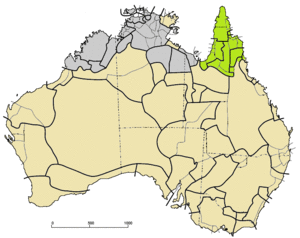| Paman | |
|---|---|
| Geographic distribution | Cape York Peninsula, Queensland |
| Linguistic classification | Pama–Nyungan
|
| Glottolog | pama1251 |
 Paman languages (green) among other Pama–Nyungan (tan) | |
The Paman /ˈpæmən/ languages are an Australian language family spoken on Cape York Peninsula, Queensland. First noted by Kenneth Hale, Paman is noteworthy for the profound phonological changes which have affected some of its descendants.[1][2]
Classification
Various classifications of the Paman languages exist. The one outlined below is that of R. M. W. Dixon, though he does not accept that these branches are necessarily related to each other.[3]
Geographically, running down the east coast, they are:
- North Cape York
- Northern Paman
- Umpila
- Umbindhamu †
- Lamalamic
- Umbuygamu †
- Lamu-Lamu
- Yalgawarra †
- Yalanjic
- Guugu Yimithirr
- Guugu Yalandji
- Barrow Point † (>> Wik?)
- Mbariman-Gudhinma †
- Djabugay †
Down the west coast, they are:
- North Cape York
- Northern Paman
- Wik
- Southwestern
- Upper Southwest Paman
- Kuuk Thaayorre
- Kuuk Yak †
- Kunjen (incl. Ogh Undjan)
- Yir-Yoront (incl. Yirrk-Thangalkl) †
- Koko-Bera (incl. Gugu Dhaw)
- Upper Southwest Paman
- Kok-Nar †
- Norman Paman
- Kurtjar
- Kuthant †
- Gugadj †
In the interior, south of Wik, they are:
- Thaypan
- Gugu Thaypan (?Rarmul) †
- Aghu Tharrnggala †
- Ikarranggal-Alungul-Angkula
- Ikarranggal †
- Alungul †
- Angkula †
- Takalak †
- Southern
- Agwamin †
- Mbabaram †
- Mbara †
- Walangama †
The name Gugu Mini means 'good speech', and has been applied to several languages in the Thaypan area.[4] 'Possum language' (Koko-Possum, Gugu Yawa) is another generic name of this area.[5]
The unclassified Marrett River language (†) was presumably Paman, though distinct from its neighbors, as presumably was Wik Paach (†). The Mayabic languages (†) to the southwest were once classified as Paman, but have been excluded in Bowern (2011).[6] Alodja may have been another Thaypan / Rarmul Pama language.[7]
See also
- Pama–Maran languages
Notes
- ^ Hale, Kenneth L. (1964). "Classification of Northern Paman Languages, Cape York Peninsula, Australia; A Research Report". Oceanic Linguistics. Oceanic Linguistics, Vol. 3, No. 2. 3 (2): 248–265. doi:10.2307/3622881. JSTOR 3622881.
- ^ Hale, Kenneth L. (1966). "The Paman group of the Pama–Nyungan phylic family. Appendix to Languages of the World: Indo-Pacific Fascicle Six, by G.N. O'Grady, C. F. & F.M. Voegelin". Anthropological Linguistics. 8 (2): 162–197.
- ^ See Dixon (2002), pp. xxx–xlii.
- ^ Y94 Gugu Mini at the Australian Indigenous Languages Database, Australian Institute of Aboriginal and Torres Strait Islander Studies
- ^ Y199 Alungul at the Australian Indigenous Languages Database, Australian Institute of Aboriginal and Torres Strait Islander Studies,
Y74 Gugu Yawa at the Australian Indigenous Languages Database, Australian Institute of Aboriginal and Torres Strait Islander Studies - ^ Bowern, Claire. 2011. "How Many Languages Were Spoken in Australia?", Anggarrgoon: Australian languages on the web, 23 December 2011 (corrected 6 February 2012)
- ^ Y219 Alodja at the Australian Indigenous Languages Database, Australian Institute of Aboriginal and Torres Strait Islander Studies
References
- Dixon, R. M. W. (2002). Australian Languages: Their Nature and Development.